Related Research Articles
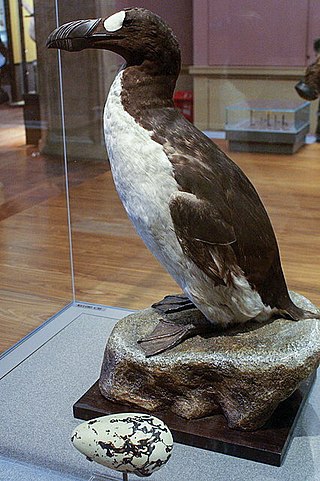
The great auk is a species of flightless alcid that became extinct in the mid-19th century. It was the only modern species in the genus Pinguinus. It is not closely related to the birds now known as penguins, which were discovered later by Europeans and so named by sailors because of their physical resemblance to the great auk.

Ornithology is a branch of zoology that concerns the study of birds. Several aspects of ornithology differ from related disciplines, due partly to the high visibility and the aesthetic appeal of birds. It has also been an area with a large contribution made by amateurs in terms of time, resources, and financial support. Studies on birds have helped develop key concepts in biology including evolution, behaviour and ecology such as the definition of species, the process of speciation, instinct, learning, ecological niches, guilds, island biogeography, phylogeography, and conservation.

An auk or alcid is a bird of the family Alcidae in the order Charadriiformes. The alcid family includes the murres, guillemots, auklets, puffins, and murrelets. The family contains 25 extant or recently extinct species that are divided into 11 genera.
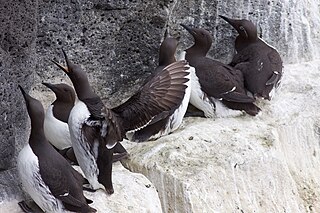
Guillemot is the common name for several species of seabird in the Alcidae or auk family. In British use, the term comprises two genera: Uria and Cepphus. In North America the Uria species are called murres and only the Cepphus species are called "guillemots". This word of French origin derives from a form of the name William, cf. French: Guillaume.

The razorbill, razor-billed auk, or lesser auk is a North Atlantic colonial seabird and the only extant member of the genus Alca of the family Alcidae, the auks. It is the closest living relative of the extinct great auk.

The common murre or common guillemot is a large auk. It has a circumpolar distribution, occurring in low-Arctic and boreal waters in the North Atlantic and North Pacific. It spends most of its time at sea, only coming to land to breed on rocky cliff shores or islands.

Francis Willughby FRS was an English ornithologist and ichthyologist, and an early student of linguistics and games.

The thick-billed murre or Brünnich's guillemot is a bird in the auk family (Alcidae). This bird is named after the Danish zoologist Morten Thrane Brünnich. The very deeply black North Pacific subspecies Uria lomvia arra is also called Pallas' murre after its describer. The genus name is from Ancient Greek ouria, a waterbird mentioned by Athenaeus. The species term lomvia is a Swedish word for an auk or diver. The English "guillemot" is from French guillemot probably derived from Guillaume, "William". "Murre" is of uncertain origins, but may imitate the call of the common guillemot.
Professor Geoffrey Alan Parker FRS is an emeritus professor of biology at the University of Liverpool and the 2008 recipient of the Darwin Medal. Parker has been called “the professional’s professional”.
Christopher Miles Perrins, is Emeritus Fellow of the Edward Grey Institute of Field Ornithology at the University of Oxford, Emeritus Fellow at Wolfson College, Oxford and Her Majesty's Warden of the Swans since 1993.
In biology, polyspermy describes the fertilization of an egg by more than one sperm. Diploid organisms normally contain two copies of each chromosome, one from each parent. The cell resulting from polyspermy, on the other hand, contains three or more copies of each chromosome—one from the egg and one each from multiple sperm. Usually, the result is an unviable zygote. This may occur because sperm are too efficient at reaching and fertilizing eggs due to the selective pressures of sperm competition. Such a situation is often deleterious to the female: in other words, the male–male competition among sperm spills over to create sexual conflict.

Uria is a genus of seabirds in the auk family known in Britain as guillemots, in most of North America as murres, and in Newfoundland and Labrador as turr. These are medium-sized birds with mainly brown or black plumage in the breeding season. They breed on the coasts of the northern Atlantic and Pacific oceans.

Bird eggs are laid by the females and range in quantity from one to up to seventeen. Clutch size may vary latitudinally within a species. Some birds lay eggs even when the eggs have not been fertilized; it is not uncommon for pet owners to find their lone bird nesting on a clutch of infertile eggs, which are sometimes called wind-eggs.

The term seabird is used for many families of birds in several orders that spend the majority of their lives at sea. Seabirds make up some, if not all, of the families in the following orders: Procellariiformes, Sphenisciformes, Pelecaniformes, and Charadriiformes. Many seabirds remain at sea for several consecutive years at a time, without ever seeing land. Breeding is the central purpose for seabirds to visit land. The breeding period is usually extremely protracted in many seabirds and may last over a year in some of the larger albatrosses; this is in stark contrast with passerine birds. Seabirds nest in single or mixed-species colonies of varying densities, mainly on offshore islands devoid of terrestrial predators. However, seabirds exhibit many unusual breeding behaviors during all stages of the reproductive cycle that are not extensively reported outside of the primary scientific literature.
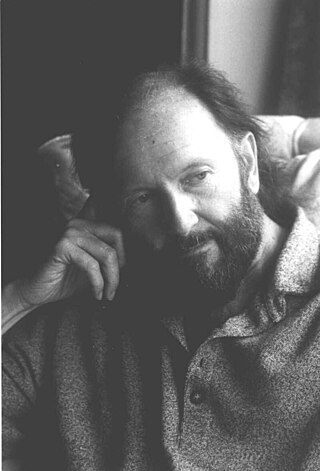
Robin Baker is a British novelist, popular science writer, lecturer and broadcaster. A best-selling author in the field of sexual biology his books have been translated into 27 different languages. These include the international bestseller Sperm Wars which was based on his own lab's original research on human sexuality. His work and ideas on the evolution of human behaviour have been featured in many radio and television programmes around the world.
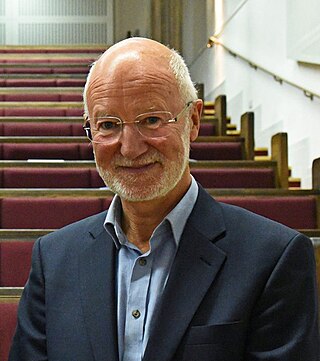
Nicholas Barry Davies FRS is a British field naturalist and zoologist, and Emeritus Professor of Behavioural Ecology at the University of Cambridge, where he is also a Emeritus Fellow of Pembroke College.
Ben C. Sheldon is the Luc Hoffmann Chair in Field Ornithology and Director of the Edward Grey Institute of Field Ornithology of the University of Oxford's Department of Zoology. He was Head of the Department of Zoology between 2016 and 2021.
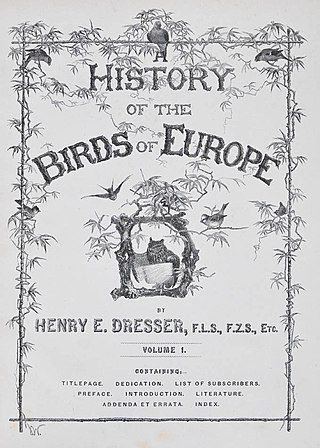
A History of the Birds of Europe, Including all the Species Inhabiting the Western Palearctic Region is a nine-volume ornithological book published in parts between 1871 and 1896. It was mainly written by Henry Eeles Dresser, although Richard Bowdler Sharpe co-authored the earlier volumes. It describes all the bird species reliably recorded in the wild in Europe and adjacent geographical areas with similar fauna, giving their worldwide distribution, variations in appearance and migratory movements.

The Max Planck Institute for Ornithology was a non-university research institution under the sponsorship of the Max Planck Society for the Advancement of Science (MPG). As of January 1st 2023, it merged with the Max Planck Institute for Neurobiology to form the new Max Planck Institute for Biological Intelligence. The institute is located in Seewiesen, which belongs to the municipality of Pöcking in Upper Bavaria. The institute’s focus was on basic scientific research in the fields of organismic biology, zoology, ornithology, neurobiology, behavioural ecology, evolutionary biology and evolutionary genetics. The institute is managed on a collegial basis, i.e. one of the two directors of the institute takes over the management for a certain time period. The last managing director was Manfred Gahr.
The Wonderful Mr Willughby: The First True Ornithologist is a 2018 biography, written by Tim Birkhead, about Francis Willughby (1635–1672), an English ornithologist, ichthyologist, entomologist, and Fellow of the Royal Society. Birkhead's work is the first book-length biography of Willughby.
References
- 1 2 3 Anon (2005). "BIRKHEAD, Prof. Timothy Robert" . Who's Who (online Oxford University Press ed.). Oxford: A & C Black. doi:10.1093/ww/9780199540884.013.10000450.(Subscription or UK public library membership required.)
- 1 2 3 "Professor Tim Birkhead | Advance HE".
- 1 2 Birkhead, Timothy Robert (1976). Breeding biology and survival of guillemots (Uria aalge). ora.ox.ac.uk (DPhil thesis). University of Oxford. OCLC 44837387. EThOS uk.bl.ethos.449886
 .
. - ↑ Anon (2004). "Professor Tim Birkhead FRS". London: royalsociety.org. Archived from the original on 23 November 2015. One or more of the preceding sentences incorporates text from the royalsociety.org website where:
"All text published under the heading 'Biography' on Fellow profile pages is available under Creative Commons Attribution 4.0 International License." -- "Royal Society Terms, conditions and policies". Archived from the original on 25 September 2015. Retrieved 9 March 2016.
{{cite web}}: CS1 maint: bot: original URL status unknown (link) - ↑ Sheffield, University of (September 2021). "Professor Tim R Birkhead FRS - Academic Staff & Independent Research Fellows - People - Animal and Plant Sciences - The University of Sheffield". www.shef.ac.uk.
- ↑ Tim Birkhead at TED
- ↑ Mark Cocker (17 October 2008). "Flights of fancy". The Guardian.
- ↑ Hemmings, N.; Birkhead, T. R. (7 November 2015). "Polyspermy in birds: sperm numbers and embryo survival". Proceedings of the Royal Society B. 282 (1818): 20151682. doi:10.1098/rspb.2015.1682. ISSN 0962-8452. PMC 4650155 . PMID 26511048.
- ↑ Birkhead, Tim (23 October 2014). "Stormy outlook for long-term ecology studies". Nature. 514 (7523): 405. Bibcode:2014Natur.514..405B. doi: 10.1038/514405a . PMID 25341754.
- ↑ Anon. "Read Tim's story". justgiving.com. Retrieved 8 January 2018.
- ↑ Birkhead, Tim R.; Thompson, Jamie E.; Biggins, John D. (1 July 2017). "Egg shape in the Common Guillemot Uria aalge and Brunnich's Guillemot U. lomvia: not a rolling matter?" (PDF). Journal of Ornithology . 158 (3): 679–685. doi:10.1007/s10336-017-1437-8. ISSN 2193-7192. S2CID 9084008.
- ↑ "Vulgar errors – the point of a Guillemot's egg - British Birds". britishbirds.co.uk. Retrieved 8 January 2018.
- ↑ Birkhead, Tim R.; Thompson, Jamie E.; Montgomerie, Robert (1 October 2018). "The pyriform egg of the Common Murre (Uria aalge) is more stable on sloping surfacesEl huevo piriforme de Uria aalge es más estable en superficies inclinadasCommon Murre egg shape and stability". The Auk. 135 (4): 1020–1032. doi: 10.1642/AUK-18-38.1 . ISSN 0004-8038. S2CID 92507158.
- ↑ Promiscuity: An Evolutionary History of Sperm Competition. Harvard University Press. 2002. ISBN 978-0-674-00666-9.
- ↑ Bodio, Stephen J. (Summer 2014). "Book Review: 'Ten Thousand Birds: Ornithology since Darwin by Tim Birkhead, Jo Wimpenny, and Bob Montgomerie". Living Bird Magazine.
- ↑ "Royal Society Winton Prize goes to 'rock star' science book", "The Guardian", London, 26 November 2013. Retrieved on 8 May 2019.
- ↑ Ju, Chenghui; Lahti, David C. (2017). "The Most Perfect Thing: Inside (and Outside) a Bird's Egg by Tim Birkhead. 2016. Bloomsbury, New York, NY, USA. xvi + 304 pp., 15 color and 3 black-and-white photographs. $27 (hardcover). ISBN 978-1632863690". The Auk. Oxford University Press (OUP). 134 (4): 922–924. doi: 10.1642/auk-17-112.1 . ISSN 0004-8038.
- ↑ Preston, Alex (17 April 2016). "Review of The Most Perfect Thing: Inside (and Outside) a Bird's Egg by Tim Birkhead". The Guardian.
- ↑ "Shortlist for The Royal Society Insight Investment Science Book Prize 2016 unveiled". royalsociety.org. Retrieved 22 September 2016.
- ↑ Freeman, Frank (17 December 2022). "Review: 'Birds and Us,' by Tim Birkhead". Star Tribune. Minnesota.
- ↑ "Review of Birds and Us by Tim Birkhead". Kirkus Reviews. 2022.
- ↑ "BoS | Biology of Spermatozoa meetings". www.bos.group.shef.ac.uk. Retrieved 8 January 2018.
- ↑ "Tim Birkhead". 4 January 2008.
- ↑ Al-Khalili, Jim (2017). "Tim Birkhead on bird promiscuity". bbc.co.uk. BBC . Retrieved 8 January 2018.
- ↑ Sheffield, University of. "Alfred Denny Museum - Alfred Denny Museum - The University of Sheffield". www.shef.ac.uk. Retrieved 8 January 2018.
- ↑ The University of Sheffield (10 February 2017), Aisha's Letter , retrieved 8 January 2018
- ↑ Birkhead, Tim (26 September 2010), The early birdwatchers , retrieved 8 January 2018
- ↑ "Elliott Coues Award, 2011". The Auk. Oxford University Press (OUP). 129 (1): 187–188. 2012. doi: 10.1525/auk.2012.129.1.187 . ISSN 0004-8038.
- ↑ Sheffield, University of. "Professor named top of the class - Latest - News - The University of Sheffield". shef.ac.uk. Retrieved 8 January 2018.